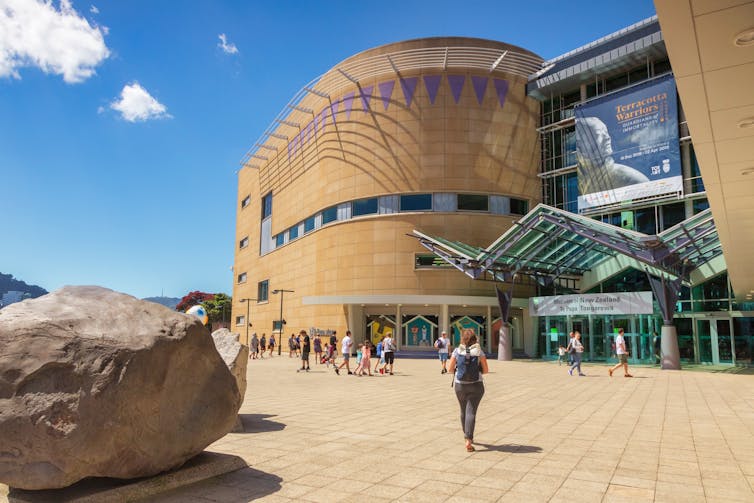 Stokkete/Shutterstock
Stokkete/ShutterstockWhen Auckland mayor Wayne Brown said in 2022 that the Auckland Art Gallery had the foot traffic of a corner dairy and cast the institution as an “uneconomic” entity, he conceded he was at risk of “being seen as something of a philistine”.
But the mayor’s comments also highlighted a very real challenge. How can New Zealand cultural organisations secure their future when the value of art and culture is seen through the economic lens of profit?
And does an overemphasis on profit make cultural groups wary of market and strategy, hampering innovation in the art and culture sector?
Our research proposes a concept we call “generative coexistence”. We suggest that when market approaches are integrated thoughtfully, market forces and cultural missions can work together and enable each other.
Why the market vs. culture debate is changing
For years, cultural organisations were shielded from the market by state funding. But while government support remained relatively consistent, there was no consistent funding strategy. With each budget round being akin to a lottery, calls for change are becoming louder.
The 2024 budget included significant reductions in arts funding. Cultural organisations were expected to find new ways to stay viable. However, as art institutions turn to practices like sponsorship, ticketed events and merchandising to boost revenue, there’s understandable concern about a potential loss of artistic integrity.
Yet, market principles and cultural values can be aligned.
In 2023, the New Zealand Symphony Orchestra launched a digital platform, NZSO+, to stream performances, open rehearsals and artistic talks. Later that year, the NZSO performed to a flock of farm chickens, to support ethical farming and, simultaneously, modernise its brand image.
The moves raised questions about whether the orchestra’s essence could be nurtured outside of concert halls. At the same time, they showed a possibility for cultural organisations to blend their authentic mission with commercial acumen, without compromising their intrinsic values.
The NZSO’s streaming strategy didn’t just address a budget shortfall. It allowed the orchestra to reach wider, younger and more diverse audiences who might not otherwise engage with classical music. Through this market-driven approach, the symphony orchestra sustained its core mission of bringing music to all New Zealanders.
Our research includes examples of cultural groups from around the world. It captures how, rather than seeing commercialisation as a “necessary evil” undermining the arts, cultural groups can use the tensions that come from the competing demands to produce creative solutions.
Here, generative coexistence allows cultural organisations to adapt in ways that not only keep the lights on but also broaden their impact.
 Wellington’s Te Papa Museum uses blockbuster ticketed exhibitions to attract a wider audience while maintaining its cultural status.
travellight/Shutterstock
Wellington’s Te Papa Museum uses blockbuster ticketed exhibitions to attract a wider audience while maintaining its cultural status.
travellight/Shutterstock
Generative coexistence in the arts
We identified three main strategies for organisations in the arts and culture sector designed to help them thrive in a world where financial and cultural goals can seem at odds with each other.
First, organisations need to embrace the commercial potential of cultural products.
When approached thoughtfully, the strong commercial appeal of cultural products can support an organisation’s core mission and create a democratic counterbalance against sponsorship dependency.
Wellington’s Te Papa Museum, for example, creates value through blockbuster ticketed exhibitions that attract a wider audience – such as last year’s Dinosaurs of Patagonia. By using selective commodification processes, Te Papa maintains its educational and cultural status and generates the revenue needed to innovate and expand its reach.
Cultural organisations also need to adopt an entrepreneurial mindset.
Organisations worldwide experiment with innovating existing business models to allow for creative and operational freedom. For example, performing art organisations are increasingly moving away from legacy models – such as venue-based events with tickets as the key revenue stream – into hybrid and digitally-led ones.
Similarly, galleries and art spaces are opting for nomadic models, eschewing permanent locations but maintaining a strong online presence. This enables cultural actors to adapt and lower reliance on funding while creating cultural value.
Finally, cultural organisations need to look into cross-disciplinary collaborations that align on shared goals. Finding a balance between financial stability and cultural integrity requires recognising opportunities to work together.
How market and cultural values can coexist
The New Zealand arts sector is still cautious about non-intuitive collaborations with adjacent fields, such as gaming, fashion or advertising. But partnering with the tech industry holds the promise of new levels of visitor engagement, while staying rooted in the commitment to community enrichment.
Cultural organisations have to navigate a complex landscape where financial pressures and cultural missions intersect and create tensions.
Our concept of generative coexistence encourages a more flexible view. Examples from around the globe show it isn’t about choosing between culture and commerce. It’s about turning tensions into a foundation for innovation, accessibility and resilience.
Arts and culture are neither luxuries nor commodities, but integral parts of a thriving society. We are certain that New Zealand’s creative sector, which is unique, resilient and economically viable, can secure its place in a future that honours both the power of art and the realities of financial sustainability.
Ksenia Kosheleva receives funding from The Foundation for Economic Education, Finland.
Julia Fehrer and Kaj Storbacka do not work for, consult, own shares in or receive funding from any company or organisation that would benefit from this article, and have disclosed no relevant affiliations beyond their academic appointment.

 3 months ago
1882
3 months ago
1882 
















 English (United States) ·
English (United States) ·